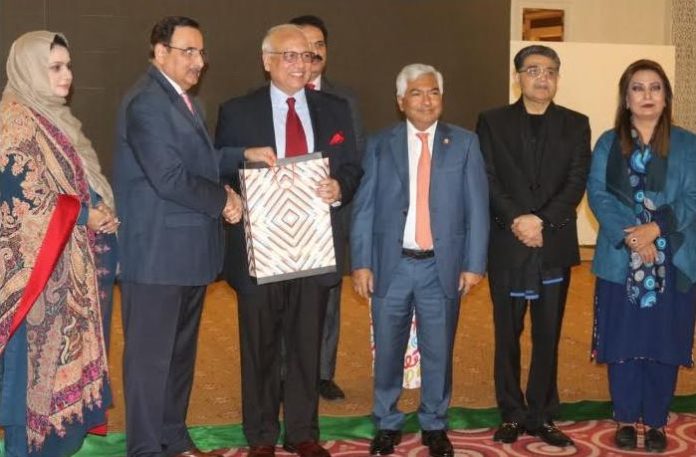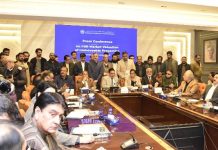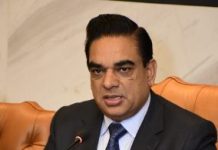ISLAMABAD, DEC 15 (DNA): The SAARC Chamber of Commerce and Industry has said the intra-trade among SAARC countries continues to remain in the low range of just 5% of the total trade of the region while this trade in NAFTA region is over 40 percent, 68 percent in EU and 27 percent in ASEAN, laying emphasis on exploring the vast untapped trade potential in SAARC region.
This was stated by the speakers at a reception held in honour of SAARC Chamber of Commerce and Industry’s President Md. Jashim Uddin, organized by the SAARC CCI Vice President Mian Anjum Nisar here at a local hotel today.
The SAARC CCI delegation, led by its President Md. Jashim Uddin, is presently on visit to Pakistan from Bangladesh with a view to revitalize the apex trade body of the South Asia region. The meeting underscored the shared goals and mutual interests, paving the way for enhanced regional cooperation. The Bangladeshi delegation reaffirmed their commitment to advancing trade, cultural exchanges, and connectivity among the regional countries.
Md. Jashim Uddin observed that South Asia with its diversified resources and skilled workforce has tremendous potential to be the fastest-growing exporting region to the globe.
He said that other regional associations like EU, ASIAN, NAFTA are doing very well and they are getting regional benefits but it’s still unfortunate for us, that we couldn’t utilize SAARC till now. We have huge potential in the area of tourism, agriculture, fisheries, industries, human development and many more. It’s time we push the government of each country to seize the untapped opportunity in this region, he added.
He added: This forum gives an immense opportunity for trade and businesses across South Asia to exhibit their products and services to grow beyond their usual parameters. It creates a platform for expanding their international trade at the export markets in South Asia and beyond.”
He highlighted the significance of government support for the South Asian business community in achieving the region’s goals. He further emphasized the need to explore connectivity possibilities at the government level and find solutions to unify all exhibitors from South Asian countries onto a single platform.
He advocated for investments and trade cooperation, leveraging opportunities for Sino-SAARC cooperation and exploring synergies with external partners like EU.
Addressing the meeting SCCI vice president Mian Anjum Nisar said that it is imperative for all to draw lessons from the successes achieved by other regional agreements, and channel their experiences of regional identity and solidarity into our efforts to propel SAARC towards new heights. It is our responsibility to find innovative and sustainable solutions to these challenges, and to work together to create a brighter future for the people of our region, he opined. The priority will be given to enhance collaboration on sectors with high growth potential such as information technology, manufacturing, energy, tourism, and agribusiness that derive tangible results, he added. South Asia is one of the fastest-growing economies in the world. We have a lot of potential, but unfortunately, we are still lagging behind to seize all the opportunities, he said.
Anjum Nisar emphasized the need to develop a comprehensive strategy aimed at eliminating obstacles that impede trade within the South Asian Association for Regional Cooperation (SAARC).
He highlighted the significance of South Asia, which is home to over a quarter of the world’s population. Despite this, he pointed out that a well-defined strategy to improve trade links between SAARC countries is still in the works. He stressed the need to address various challenges hindering intra-SAARC trade, such as visa restrictions for the general public, particularly businessmen, as well as facilitating seamless transportation of goods, investment, and services across respective countries. He pointed out that SAARC’s share in global exports stands at 1.9%, while ASEAN enjoys an 8% share. Over the period from 2019 to 2023, SAARC’s total exports rose by 24% to $462 billion, while ASEAN countries experienced a 52% increase to $2 trillion.
Mian Anjum Nisar highlighted the lack of banking connectivity among SAARC member states as a major obstacle preventing the realization of the region’s trade potential. He underscored the need for Pakistan to address issues such as rupee devaluation, inflation, and the cost of doing business to secure a significant share in intra-SAARC trade. Nisar noted that the substantial devaluation of the Pakistani rupee has led to a manifold increase in external debts.
The speakers stressed the importance of enhancing productivity and promoting the use of indigenous raw materials to reduce the cost of doing business. They also called for improved connectivity between SAARC countries, not only through road and railway networks but also through ports, shipping, and aviation, which would facilitate and enhance mutual connectivity.
They emphasized the importance of financial cooperation among SAARC countries to bridge infrastructure gaps and increase productivity.

















